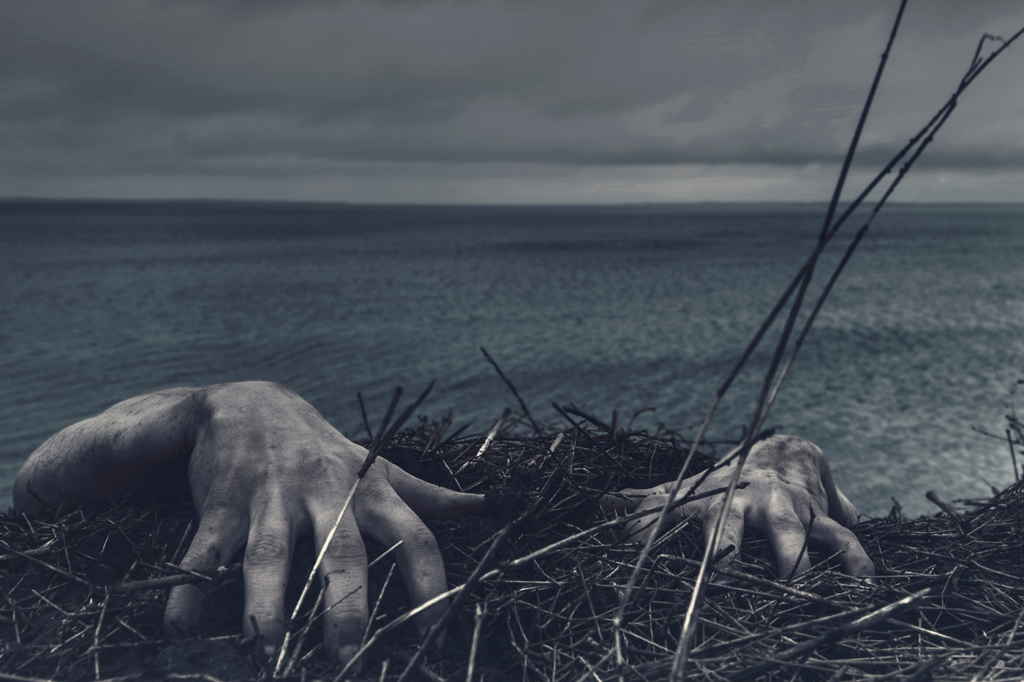Spirits haunt the postmodern West. But ghosts, fiends, and fantastic beasts don’t just come out at Halloween. “Fear is the beginning of wisdom,” and storytellers throughout the ages have seized on society’s scares and panics to make monsters, enlisting supernatural reality to convey eternal truth.
As fearsome as they are, classical monsters like Frankenstein and Dracula have the capacity to make us better people. Hailing from aristocratic Europe, both Mary Shelley and Bram Stoker imbued a consciousness of sin and its consequences into their novels. Whether embodying the excesses of the elite (Dracula) or the alienation of the poor (Frankenstein), the monsters of classic horror stories exist within a moral universe.
Amid the revolutionary chaos of the 1960s, ingenious filmmaking hatched two quintessentially American monsters that continue to inspire enduring obsession. Bigfoot and the Zombie personify competing psychological visions of the New World’s political anxieties and spiritual condition.
America’s greatest political critic, Alexis de Tocqueville, suggested that a democracy without a telos can sustain itself only by cannibalizing its aristocratic foundations. Enlightenment thinking has its limitations, and its mythological monsters reflect this sobering reality.
Start your day with Public Discourse
Sign up and get our daily essays sent straight to your inbox.If classical philosophy, represented in “monster-form” as Bigfoot, is preparation for a noble death, zombies are an anticipation of the coming genocide. Bigfoot, with his revivifying magic, restocks society with heroes, while zombies reduce society to a gaggle of warring clans whose lives are “nasty, brutish and short.”
Bigfoot
Although he first appeared in the 1967 Patterson-Gimlin home movie, Bigfoot falls squarely in the tradition of fire-breathing dragons, griffins, and the troll under the bridge.
These creatures all live in a forest, and their presence transmutes an ordinary wood into something enchanted. It becomes a place of danger and transformation, a setting where strange creatures inspire the possibility of heroic action. Exploding onto the scene at a time of political upheaval, the reclusive, lumbering giant is a reminder of the primordial chaos that awaits just outside the limits of civilization. He reflects an innate uneasiness with the modern lifestyle and regret for a vanishing hierarchical order.
Terror is usually not the first reaction after an encounter with the beast. (Yeti is not an American name). Most Bigfoot stories are not physical confrontations. Often portrayed as contending with a sense of loss, Bigfoot is not a violent creature but a melancholy one. He reminds us of a time gone by. His purpose is to produce individuals of a distinctly American character—optimistic, contrarian, and religiously inclined. By simply glimpsing him, the believer experiences an internal transformation and completes a quest.
Alexis de Tocqueville, who held deep reservations about a democracy’s ability to foster a moral society, would welcome Bigfoot as positive development in American mythology. A proponent of old-world hierarchies who was suspicious of democratic egalitarianism, Tocqueville would recognize Bigfoot as existing on a higher order of being than his zombie contemporary, seeing him as a reminder of a natural hierarchy. Consider the old story of the Native American, fishing on the banks of a great river, who comes face-to-face with the beast. Cornered, the man sets the entire catch at Bigfoot’s feet in supplication, hoping he will not kill him. Bigfoot picks up the catch of fish, divides it in half, and walks away.
The dividing of the fish suggests Bigfoot is a creature who takes on moral and spiritual qualities in the American legendarium. He is not a replacement for traditional religion, per se, but a manifestation of that same instinct. Bigfoot demands a sacrifice, yet he embodies a kind of justice.
Man’s response to the supernatural has always taken the form of sacrifice. Primitive man sacrificed animals or other humans to appease rapacious deities. Yet Bigfoot is portrayed as relational, not tyrannical. In a certain sense, Bigfoot is an aristocrat among mythical beasts. A worthy successor to the monsters of old, he recalls our primordial stories while acting as a crucible for individuals to achieve heroic virtue.
Despite his classical nature, Bigfoot is a departure from his European ancestors. Unlike Dracula, he is not evil. Unlike Frankenstein, he is not a creation of hubristic scientific meddling. Born of nature, not moral compromise, Bigfoot is also distinct from his American cousin, the democratic zombie. Bigfoot is a keeper of a covenant much older than politics. He is a guardian of religious instinct, that ghost in the machine that makes civilization and its heroes possible.
Zombies
In 1968, George A. Romero invented the motion-picture “zombie” in Night of the Living Dead. Without ever mentioning the word, he created a monster that Tocqueville would have recognized as distinctively American.
Zombies are the monsters of democracy. They are the ungovernable mob that undermines the existing order without putting anything in its place—a revolutionary riot whose defining characteristics are appetite and apathy. To a political philosopher like Leo Strauss, they might be interpreted as the culmination of enlightenment thinking: a society without a telos. They are all desire and no purpose.
In his “Three Waves of Modernity,” Strauss suggests that modern man no longer knows what he wants. He no longer believes that he can know what is good or bad, right or wrong, and that we have arrived at a point in history when both faith and reason have lost their power.
Relentlessly secular, zombies denote the fin de siècle for an enlightenment society that initially appeared prosperous, but ultimately cannot sustain itself. The fictional zombie is like the postmodern West. It moves forward as a kind of progressive bulldozer, destroying anything that falls across its path, including tradition, custom, and history. Zombies thoughtlessly destroy the past, moving ever forward without a destination. They violently but pointlessly “remake the world.”
Zombies are a death cult with no magic. Encounters with zombies don’t ennoble human beings; they debase them. An interaction results in death or dread, but never heroic transformation. Slaughtering a zombie is perfunctory; killing one is like killing a thousand. In fact, to kill a zombie is not a victory at all. Heroic virtue is impossible when killing zombies. You must rise above yourself to slay a dragon, but you must lower yourself to kill what is already dead.
Killing zombies conjures Nietzsche’s vision of the victory of the superman over the decayed “herd man” who exists without ideals or aspirations. In fact, zombie killing transforms the defensive combatant into a type of fascist. With little effort, the protagonist imposes his will with impunity over the weak and easily herded masses. Zombies can be wiped out by the thousands without committing murder. As Stalin said, “One death is a tragedy, a million deaths a statistic.”
Unlike the hierarchical monsters created by Stoker and Shelley, zombies cannot nourish the soul or offer the possibility of renewal. As the monsters to end all monsters, zombies exist in a kind of twilight struggle, immersed in an eschatological state of war. Vestiges of a toppled civilization—the hum of a lone engine or a lonely light in a single window—incite them to viciously attack. If zombies possess any instinct, it’s a compulsion to eviscerate the good, the true, and beautiful. Like Grendel, the monster of Beowulf, who is driven into a frenzy by the warriors in the mead halls “singing songs of creation,” zombies retain a preternatural gift for detecting and extinguishing human flourishing. Because they practice the politics of power, zombies coerce human beings into a corrupt paradigm for heroic action, in which even the winners lose.
The Reality behind American Monster Myths
With one foot in America’s agrarian past, the contrarian Bigfoot is nostalgic, magical, and aristocratic. He is a mythical beast who binds us to tradition and reminds us of the natural order of creation. There is a longing for the legend of Bigfoot and all the hope that it entails. Tens of thousands of fantastical sightings are reported each year, and Bigfoot devotees go to Bigfoot conferences, which function as repositories of oral and written tradition where meaning is preserved. By contrast, the leveling zombie is a projection of civilizational pessimism. Post-modern and anti-heroic zombie aficionados participate in Zombie Walks and Zombie Runs—collectivist pantomimes where followers embark on faux excursions into bloodlust and negation.
It’s a surprisingly short leap from the political philosophy of monsters to the depths of religious phenomenology. For Catholics, the days after Halloween are All Saints Day and All Souls Day, reminders of the debt we owe to the past. Such inherited narratives are impossible in zombie land, since custom and tradition are the primary food group for the undead.
Lacking both telos and mythos, zombies are not conducive to aspirational storytelling. To identify with a character in a great story, we must see the world through that character’s eyes. Even evil characters can offer insight into the human condition. But zombies are anti-characters, with no past, no memory, and no identity. They are unidimensional. The deterministic zombie is utterly predictable. Still, it’s ultimately not zombies themselves that should alarm us, but the type of men produced by interacting with the undead. Zombies should terrify not for the obvious reasons, but because they create monsters more fearsome than themselves—cruel men with no semblance of morality, empathy, or respect for tradition.
But the sterility of the undead reaches far beyond the silencing of ancestral voices. Zombies refute the past and negate the future because they accept neither death nor life as nature dictates. Incapable of reproduction, they multiply by killing. This is a perversion and an inversion of the procreative instinct. Hell, as described in Dante’s Inferno, with its rule of contrapasso, demonstrates well the idea of sin as its own punishment. It’s an idea that perfectly aligns with the civilizational curse of zombies. In a culture that relentlessly trespasses against its foundational values, zombies represent an equal and fitting punishment for enlightenment man, who can no longer discern life from liberty.
By the measure of its monsters, America’s spiritual condition is bipolar. Suspended in the popular imagination for the last fifty years are two competing visions of horror. Longer-term prospects, however, may hinge on the meaning of mythology. Brave knights once battled dragons, defining for the West a model of heroic virtue. Facing his fate alone, the self-sacrificing protagonist conjures spirits that are Christic. The metanoia of the Bigfoot encounter is Christic as well—the reenactment of an age-old drama. Like all great mythology, the legend of Bigfoot trades in symbols that communicate not just to our minds but to our hearts: symbols that speak to us not through syllogisms but through anamnesis and moral intuition.
Zombies hold no such claim on a moral universe or the human heart. Their appeal is limited to visceral reaction, animal cunning, the fight-or-flight instinct of the hunted beast. The status of the zombie can never reach the level of mythology because it’s not a story. It’s a cry of despair.














